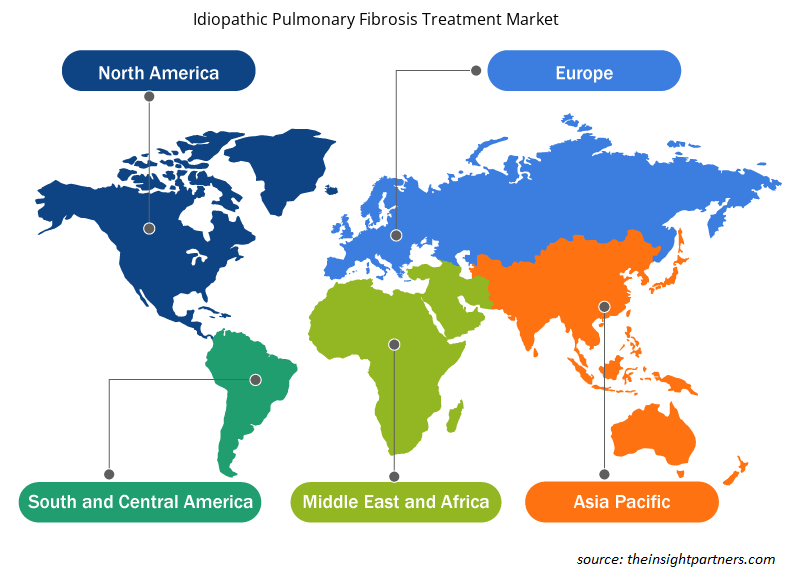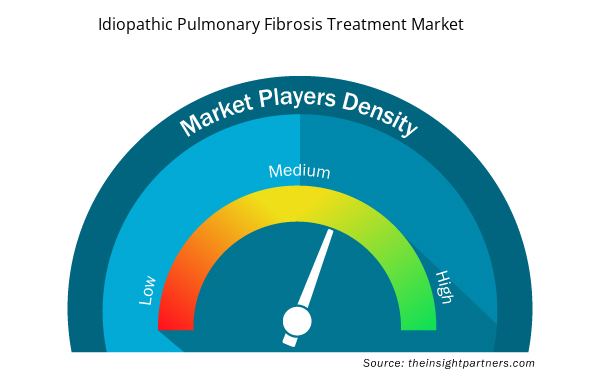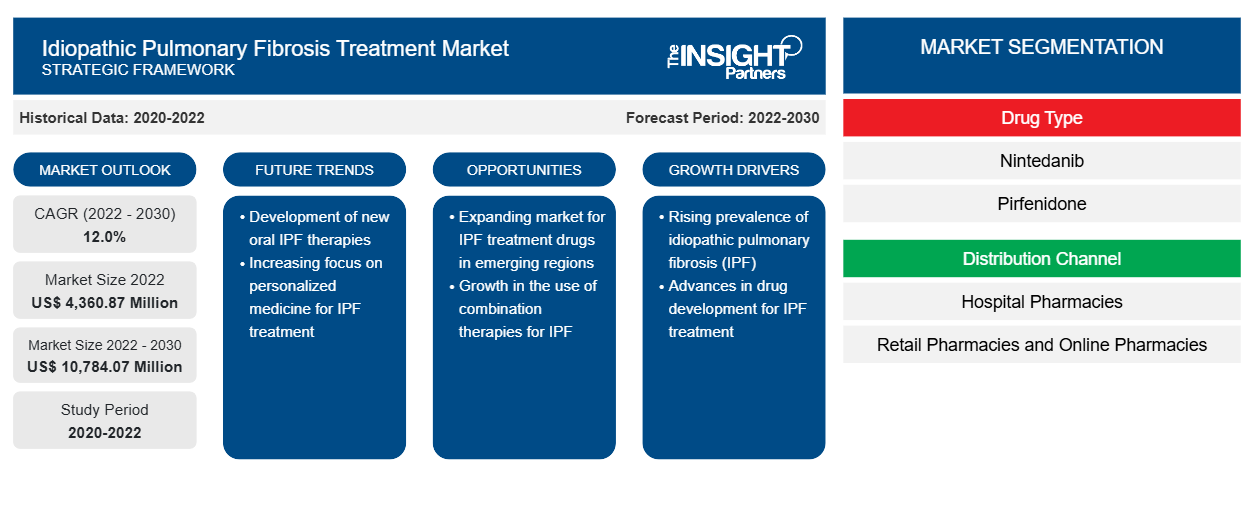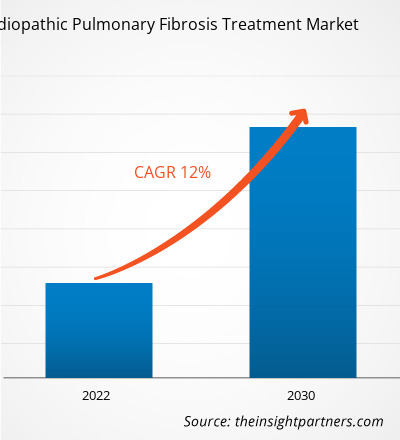[Informe de investigación] Se proyecta que el tamaño del mercado de tratamiento de la fibrosis pulmonar idiopática aumentará de US$ 4.360,87 millones en 2022 a US$ 10.784,07 millones en 2030; se estima que el mercado crecerá a una CAGR del 12,0% durante 2022-2030.
Perspectiva del analista:
La fibrosis pulmonar idiopática es una enfermedad crónica que afecta el tejido que rodea los alvéolos de los pulmones. Se desarrolla cuando los tejidos pulmonares se vuelven rígidos y gruesos por razones desconocidas, y estos cambios dan lugar a cicatrices permanentes en los pulmones con el tiempo, lo que dificulta la respiración de los pacientes. Actualmente, no existe una cura precisa para la fibrosis pulmonar idiopática. Los tratamientos como la rehabilitación pulmonar, los medicamentos y los procedimientos quirúrgicos retrasan el daño pulmonar y ayudan a mejorar la calidad de vida de los pacientes.
El La creciente prevalencia de la fibrosis pulmonar idiopática y el aumento del número de fumadores impulsarán la demanda de medicamentos eficaces para su tratamiento en los próximos años. Es probable que las investigaciones en curso para introducir medicamentos eficaces para el tratamiento de la fibrosis pulmonar idiopática sigan beneficiando al mercado en el futuro. En la actualidad, el gasto sanitario ha aumentado tanto en los mercados desarrollados como en los emergentes, lo que se espera que anime a los fabricantes de este mercado a consolidar sus esfuerzos centrados en el desarrollo de productos nuevos e innovadores.
Descripción general del mercado:
La fibrosis es la deposición de tejido conectivo que se produce como parte del proceso de curación normal o la deposición de tejido sobrante que se produce como un proceso patológico. La fibrosis pulmonar idiopática afecta al tejido conectivo de los pulmones y los alvéolos (sacos de aire en los pulmones). La afección puede provocar falta de aire en las personas que realizan sus tareas rutinarias, que no son tediosas para las personas con buena salud. El crecimiento del mercado de tratamiento de la fibrosis pulmonar idiopática se atribuye a la creciente carga de enfermedades fibróticas y al aumento del número de personas que fuman cigarrillos. Se espera que las actividades de investigación y desarrollo de ritmo rápido, que conducen a avances tecnológicos en los tratamientos, brinden oportunidades de crecimiento para el mercado de tratamiento de la fibrosis pulmonar idiopática en los próximos años.
Personalice este informe según sus necesidades
Obtendrá personalización en cualquier informe, sin cargo, incluidas partes de este informe o análisis a nivel de país, paquete de datos de Excel, así como también grandes ofertas y descuentos para empresas emergentes y universidades.
- Obtenga las principales tendencias clave del mercado de este informe.Esta muestra GRATUITA incluirá análisis de datos, desde tendencias del mercado hasta estimaciones y pronósticos.
Conductor del mercado:
La creciente carga deLa fibrosis pulmonar idiopática impulsa el mercado de tratamiento de la fibrosis pulmonar idiopática
Según datos de la Asociación Estadounidense del Pulmón, actualizados en noviembre de 2022, cada año se diagnostican en Estados Unidos aproximadamente 50.000 nuevos casos de fibrosis pulmonar idiopática. Los síntomas de esta afección son más notorios en pacientes de entre 50 y 70 años. Según un artículo publicado en el British Medical Journal en septiembre de 2022, la prevalencia estimada de fibrosis pulmonar idiopática en unidades de atención especializada en 2021 fue de 36,0 por 100.000. El número de pacientes que padecen fibrosis pulmonar idiopática está aumentando en todo el mundo debido a factores de riesgo comunes como el envejecimiento, la obesidad, la presión arterial alta (hipertensión) o los antecedentes familiares, y la afección se está convirtiendo en una carga socioeconómica importante para las economías. Por lo tanto, el creciente número de pacientes con fibrosis pulmonar idiopática impulsa el crecimiento del mercado del tratamiento de enfermedades fibróticas. fibrotic disease treatment market growth.
Análisis segmental:
Según el tipo de fármaco, el mercado de tratamiento de la fibrosis pulmonar idiopática se segmenta en nintedanib, pirfenidona y otros. El segmento de nintedanib tuvo una mayor participación de mercado en 2022. Se prevé que el segmento de otros registre una CAGR más alta del 46,3 % durante 2022-2030. La pirfenidona y el nintedanib son los medicamentos populares que se recetan para tratar enfermedades fibróticas.
Análisis regional:
América del Norte domina el mercado mundial de tratamiento de la fibrosis pulmonar idiopática. El mercado en América del Norte se valoró en 2.362,95 millones de dólares en 2022 y se proyecta que alcance los 5.527,28 millones de dólares en 2030; se espera que registre una CAGR del 11,2% durante 2022-2030. El mercado de tratamiento de la fibrosis pulmonar idiopática de América del Norte está segmentado en Estados Unidos, Canadá y México. La creciente carga de la fibrosis pulmonar idiopática y los avances tecnológicos en los tratamientos benefician al mercado de tratamiento de la fibrosis pulmonar idiopática en América del Norte. Los lanzamientos de productos y las iniciativas estratégicas de los actores clave del mercado también contribuyen al crecimiento del mercado. Con el creciente número de actividades de investigación y desarrollo para tratar la fibrosis pulmonar idiopática, se están introduciendo medicamentos mejorados en el mercado, lo que se traduce en un mejor acceso a los medicamentos para un grupo más amplio de pacientes. Además, las amplias aprobaciones de la FDA en la región alientan a las empresas a lanzar productos tecnológicamente sofisticados.
Con la creciente prevalencia de la fibrosis pulmonar idiopática y el elevado gasto sanitario, Europa ocupa la segunda posición en el mercado mundial de tratamiento de enfermedades fibróticas. Se espera que Alemania domine el mercado europeo de tratamiento de la fibrosis pulmonar idiopática gracias a un mejor acceso a productos y servicios tecnológicamente avanzados en el sector sanitario.
Se espera que Asia Pacífico registre la CAGR más rápida en el mercado mundial de tratamiento de la fibrosis pulmonar idiopática durante 2022-2030. El crecimiento proyectado del mercado se puede atribuir a la aceptación y adopción generalizadas de tecnologías de vanguardia que producen resultados precisos en un tiempo significativamente más corto. Las industrias de la salud en toda la región están aprovechando las innovaciones en inteligencia artificial , automatización y transformación digital, impulsando la eficiencia y la productividad de los profesionales médicos. La transformación en curso en varias industrias fortalece a las empresas y economías en Asia Pacífico, lo que les permite posicionarse como el centro de más rápido desarrollo con un enfoque dinámico y con visión de futuro para el progreso sostenible.
Análisis de los jugadores clave:
El análisis del mercado del tratamiento de la fibrosis pulmonar idiopática se basa en actores clave como Genentech, Inc. y Boehringer Ingelheim International GmbH.
Perspectivas regionales del mercado de tratamiento de la fibrosis pulmonar idiopática
Los analistas de Insight Partners explicaron en detalle las tendencias y los factores regionales que influyen en el mercado de tratamiento de la fibrosis pulmonar idiopática durante el período de pronóstico. Esta sección también analiza los segmentos y la geografía del mercado de tratamiento de la fibrosis pulmonar idiopática en América del Norte, Europa, Asia Pacífico, Oriente Medio y África, y América del Sur y Central.

- Obtenga datos regionales específicos para el mercado de tratamiento de la fibrosis pulmonar idiopática
Alcance del informe de mercado sobre el tratamiento de la fibrosis pulmonar idiopática
| Atributo del informe | Detalles |
|---|---|
| Tamaño del mercado en 2022 | US$ 4.360,87 millones |
| Tamaño del mercado en 2030 | US$ 10.784,07 millones |
| CAGR global (2022-2030) | 12,0% |
| Datos históricos | 2020-2022 |
| Período de pronóstico | 2022-2030 |
| Segmentos cubiertos | Por tipo de fármaco
|
| Regiones y países cubiertos | América del norte
|
| Líderes del mercado y perfiles de empresas clave |
|
Densidad de actores del mercado de tratamiento de la fibrosis pulmonar idiopática: comprensión de su impacto en la dinámica empresarial
El mercado de tratamiento de la fibrosis pulmonar idiopática está creciendo rápidamente, impulsado por la creciente demanda de los usuarios finales debido a factores como la evolución de las preferencias de los consumidores, los avances tecnológicos y una mayor conciencia de los beneficios del producto. A medida que aumenta la demanda, las empresas amplían sus ofertas, innovan para satisfacer las necesidades de los consumidores y aprovechan las tendencias emergentes, lo que impulsa aún más el crecimiento del mercado.
La densidad de actores del mercado se refiere a la distribución de las empresas o firmas que operan dentro de un mercado o industria en particular. Indica cuántos competidores (actores del mercado) están presentes en un espacio de mercado determinado en relación con su tamaño o valor total de mercado.
Las principales empresas que operan en el mercado del tratamiento de la fibrosis pulmonar idiopática son:
- CH Boehringer Ingelheim International GmbH
- Compañía Bristol-Myers Squibb
- F. Hoffmann-La Roche Ltd
- AstraZeneca
- Shionogi y Cía. Ltda.
Descargo de responsabilidad : Las empresas enumeradas anteriormente no están clasificadas en ningún orden particular.

- Obtenga una descripción general de los principales actores clave del mercado de tratamiento de la fibrosis pulmonar idiopática
Desarrollos recientes:
Las estrategias inorgánicas y orgánicas, como las fusiones y adquisiciones, son ampliamente adoptadas por las empresas del mercado de tratamiento de la fibrosis pulmonar idiopática. A continuación, se enumeran algunos desarrollos recientes:
- En mayo de 2023, Boehringer Ingelheim inició el desarrollo clínico de BI 765423, un innovador anticuerpo inhibidor de IL-11. El estudio de fase 1 (NCT05658107) se centró en evaluar su seguridad, tolerabilidad y farmacocinética en voluntarios sanos. Los estudios preclínicos han mostrado resultados prometedores de este fármaco anti-IL-11 en la inhibición y posible reversión de la fibrosis en varios casos fibróticos.
- En octubre de 2022, Boehringer Ingelheim inscribió al primer paciente estadounidense en el estudio de fase III FIBRONEER-IPF, que evalúa BI 1015550. BI 1015550 es un inhibidor experimental de la fosfodiesterasa 4B (PDE4B) descubierto para el tratamiento de personas que padecen fibrosis pulmonar idiopática. El estudio forma parte del programa global FIBRONEER, que incluye dos estudios de fase III: FIBRONEER-IPF en pacientes con fibrosis pulmonar idiopática y FIBRONEER-ILD en adultos con otras enfermedades pulmonares intersticiales fibrosantes progresivas (ILD).
- En septiembre de 2022, Bellerophon Therapeutics, Inc. anunció que la FDA aceptó la solicitud de reducción del tamaño del ensayo para su actual ensayo de registro de fase 3 REBUILD de INOpulse, indicado para el tratamiento de la enfermedad pulmonar intersticial fibrótica (LD).
- En mayo de 2022, ArisGlobal, líder mundial en soluciones de seguridad de medicamentos, adquirió la innovación digital BRASS de Boehringer Ingelheim. La adquisición le permitió a la primera mejorar su plataforma tecnológica LifeSphere al integrar BRASS en LifeSphere Clarity. Esta integración ha contribuido al avance de la farmacovigilancia y la seguridad del paciente en toda la industria. Además, ArisGlobal ha ampliado su presencia comercial en diagnósticos clínicos en varias regiones del mundo, consolidando su posición global.
- En marzo de 2022, Bristol Myers Squibb, una empresa farmacéutica líder, anunció la adquisición de Turning Point Therapeutics, Inc. por US$ 76,00 por acción a través de un acuerdo de fusión definitivo. Esta adquisición ha fortalecido significativamente la presencia global de Bristol Myers Squibb en el mercado farmacéutico, lo que le permite ser más proactiva a la hora de aportar innovaciones a la industria y, al mismo tiempo, ampliar su cartera de terapias y tratamientos que salvan vidas.
- Análisis histórico (2 años), año base, pronóstico (7 años) con CAGR
- Análisis PEST y FODA
- Tamaño del mercado Valor/volumen: global, regional, nacional
- Industria y panorama competitivo
- Conjunto de datos de Excel



Report Coverage
Revenue forecast, Company Analysis, Industry landscape, Growth factors, and Trends

Segment Covered
This text is related
to segments covered.

Regional Scope
North America, Europe, Asia Pacific, Middle East & Africa, South & Central America

Country Scope
This text is related
to country scope.
Preguntas frecuentes
The global fibrotic diseases treatment market, based on treatment, is segmented into drug type and distribution channel. Based on drug type, the idiopathic pulmonary fibrosis treatment market is segmented into nintedanib, pirfenidone, and others. The nintedanib segment held a larger market share in 2022. The others segment is anticipated to register a higher CAGR of 46.3% during 2022–2030. Pirfenidone and nintedanib are the popular medicines prescribed to treat fibrotic diseases.
By distribution channel, the global idiopathic pulmonary fibrosis treatment market is categorized into hospital pharmacies, retail pharmacies, and online pharmacies. The hospital pharmacies segment held the largest market share in 2022. The online pharmacies segment is anticipated to register the highest CAGR of 17.4% during 2022–2030.
The enteral nutrition market is expected to be valued at US$ 10,784.07 million in 2030.
The fibrotic diseases treatment market was valued at US$ 4,360.87 million in 2022.
The fibrotic diseases treatment market majorly consists of the players such as F. Hoffmann-La Roche Ltd; C.H. Boehringer Ingelheim International GmbH; AstraZeneca.; Bristol-Myers Squibb Company; Shionogi and Co. Ltd.; and Cipla Ltd.
Idiopathic pulmonary fibrosis is a chronic condition that affects the tissue surrounding the alveoli in the lungs. It develops when lung tissues become stiff and thick for unknown reasons, and these changes result in permanent scarring in the lungs over time, which makes breathing difficult among patients. Currently, there is no precise cure for idiopathic pulmonary fibrosis. Treatments such as pulmonary rehabilitation, medicines, and surgical procedures slow down lung damage and help enhance the quality of patients’ lives.
The growth of the idiopathic pulmonary fibrosis treatment market is attributed to the surging burden of idiopathic pulmonary fibrosis and the increasing number of people smoking cigarettes.
Trends and growth analysis reports related to Life Sciences : READ MORE..
The List of Companies - Fibrotic Diseases Treatment Market
- C.H. Boehringer Ingelheim International GmbH
- Bristol-Myers Squibb Company
- F. Hoffmann-La Roche Ltd
- AstraZeneca
- Shionogi and Co. Ltd.
- Cipla Ltd
- Others
The Insight Partners performs research in 4 major stages: Data Collection & Secondary Research, Primary Research, Data Analysis and Data Triangulation & Final Review.
- Data Collection and Secondary Research:
As a market research and consulting firm operating from a decade, we have published and advised several client across the globe. First step for any study will start with an assessment of currently available data and insights from existing reports. Further, historical and current market information is collected from Investor Presentations, Annual Reports, SEC Filings, etc., and other information related to company’s performance and market positioning are gathered from Paid Databases (Factiva, Hoovers, and Reuters) and various other publications available in public domain.
Several associations trade associates, technical forums, institutes, societies and organization are accessed to gain technical as well as market related insights through their publications such as research papers, blogs and press releases related to the studies are referred to get cues about the market. Further, white papers, journals, magazines, and other news articles published in last 3 years are scrutinized and analyzed to understand the current market trends.
- Primary Research:
The primarily interview analysis comprise of data obtained from industry participants interview and answers to survey questions gathered by in-house primary team.
For primary research, interviews are conducted with industry experts/CEOs/Marketing Managers/VPs/Subject Matter Experts from both demand and supply side to get a 360-degree view of the market. The primary team conducts several interviews based on the complexity of the markets to understand the various market trends and dynamics which makes research more credible and precise.
A typical research interview fulfils the following functions:
- Provides first-hand information on the market size, market trends, growth trends, competitive landscape, and outlook
- Validates and strengthens in-house secondary research findings
- Develops the analysis team’s expertise and market understanding
Primary research involves email interactions and telephone interviews for each market, category, segment, and sub-segment across geographies. The participants who typically take part in such a process include, but are not limited to:
- Industry participants: VPs, business development managers, market intelligence managers and national sales managers
- Outside experts: Valuation experts, research analysts and key opinion leaders specializing in the electronics and semiconductor industry.
Below is the breakup of our primary respondents by company, designation, and region:

Once we receive the confirmation from primary research sources or primary respondents, we finalize the base year market estimation and forecast the data as per the macroeconomic and microeconomic factors assessed during data collection.
- Data Analysis:
Once data is validated through both secondary as well as primary respondents, we finalize the market estimations by hypothesis formulation and factor analysis at regional and country level.
- Macro-Economic Factor Analysis:
We analyse macroeconomic indicators such the gross domestic product (GDP), increase in the demand for goods and services across industries, technological advancement, regional economic growth, governmental policies, the influence of COVID-19, PEST analysis, and other aspects. This analysis aids in setting benchmarks for various nations/regions and approximating market splits. Additionally, the general trend of the aforementioned components aid in determining the market's development possibilities.
- Country Level Data:
Various factors that are especially aligned to the country are taken into account to determine the market size for a certain area and country, including the presence of vendors, such as headquarters and offices, the country's GDP, demand patterns, and industry growth. To comprehend the market dynamics for the nation, a number of growth variables, inhibitors, application areas, and current market trends are researched. The aforementioned elements aid in determining the country's overall market's growth potential.
- Company Profile:
The “Table of Contents” is formulated by listing and analyzing more than 25 - 30 companies operating in the market ecosystem across geographies. However, we profile only 10 companies as a standard practice in our syndicate reports. These 10 companies comprise leading, emerging, and regional players. Nonetheless, our analysis is not restricted to the 10 listed companies, we also analyze other companies present in the market to develop a holistic view and understand the prevailing trends. The “Company Profiles” section in the report covers key facts, business description, products & services, financial information, SWOT analysis, and key developments. The financial information presented is extracted from the annual reports and official documents of the publicly listed companies. Upon collecting the information for the sections of respective companies, we verify them via various primary sources and then compile the data in respective company profiles. The company level information helps us in deriving the base number as well as in forecasting the market size.
- Developing Base Number:
Aggregation of sales statistics (2020-2022) and macro-economic factor, and other secondary and primary research insights are utilized to arrive at base number and related market shares for 2022. The data gaps are identified in this step and relevant market data is analyzed, collected from paid primary interviews or databases. On finalizing the base year market size, forecasts are developed on the basis of macro-economic, industry and market growth factors and company level analysis.
- Data Triangulation and Final Review:
The market findings and base year market size calculations are validated from supply as well as demand side. Demand side validations are based on macro-economic factor analysis and benchmarks for respective regions and countries. In case of supply side validations, revenues of major companies are estimated (in case not available) based on industry benchmark, approximate number of employees, product portfolio, and primary interviews revenues are gathered. Further revenue from target product/service segment is assessed to avoid overshooting of market statistics. In case of heavy deviations between supply and demand side values, all thes steps are repeated to achieve synchronization.
We follow an iterative model, wherein we share our research findings with Subject Matter Experts (SME’s) and Key Opinion Leaders (KOLs) until consensus view of the market is not formulated – this model negates any drastic deviation in the opinions of experts. Only validated and universally acceptable research findings are quoted in our reports.
We have important check points that we use to validate our research findings – which we call – data triangulation, where we validate the information, we generate from secondary sources with primary interviews and then we re-validate with our internal data bases and Subject matter experts. This comprehensive model enables us to deliver high quality, reliable data in shortest possible time.


 Obtenga una muestra gratuita de este informe
Obtenga una muestra gratuita de este informe